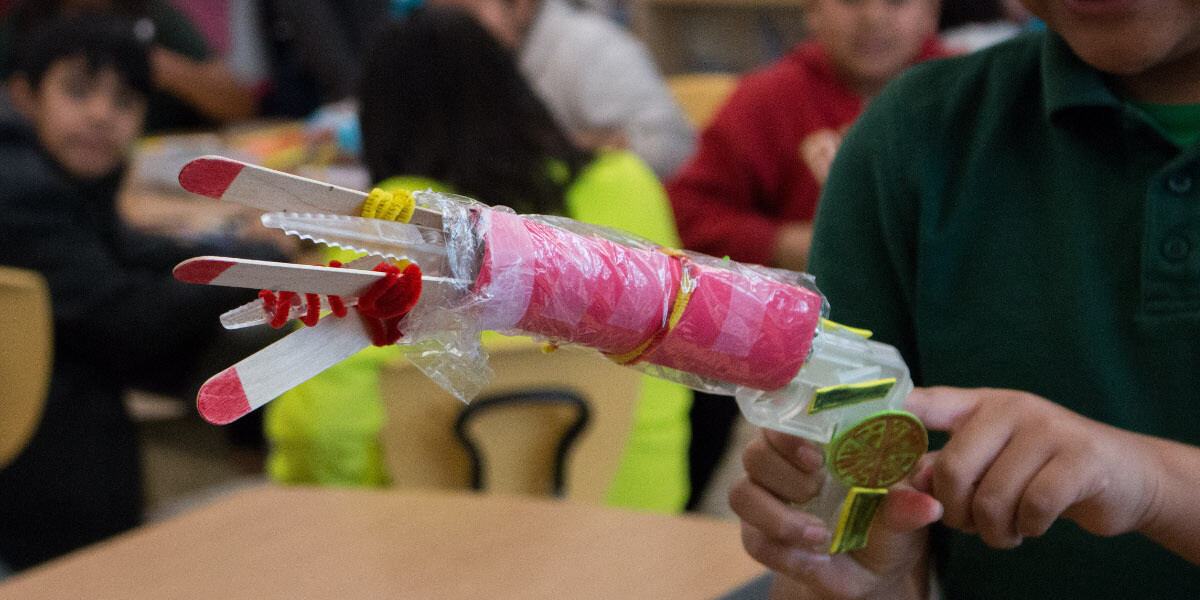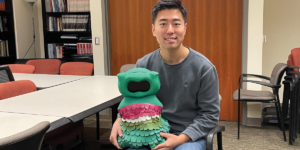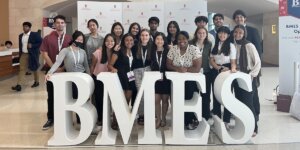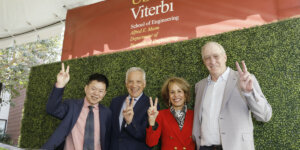
FIFTH GRADERS AT QUINCY JONES ELEMENTARY LEARN ABOUT PROSTHETICS FROM USC VITERBI STUDENTS PHOTO/ VALENTINA SUAREZ
On a chilly Friday morning in February, Mr. Montgomery’s fifth graders at Quincy Jones Elementary School started their day by learning how to build prosthetic arms. Guided by USC student volunteers from the Associated Students of Biomedical Engineering (ASBME), the children were some of the first beneficiaries of the organization’s new STEM outreach program for local schools.
The initiative, called Project in a Box, aims to stimulate interest in biomedical engineering and develop problem-solving skills from a young age. In its first semester, the group has already reached hundreds of local children.
Student members of ASBME designed and launched the initiative in the spring of 2016. Groups of seven to eight undergraduate students visit local schools once every three weeks to lead hour-long lessons. In the prosthetics lesson, children learn what biomedical engineers do and how they can help people with health problems, with a focus on those suffering from limb loss.
One goal of the lessons is to get kids thinking creatively like engineers about relating design to function. The group also hopes to demystify engineering and to show children that they’re capable of succeeding in the field.
“We’re not only trying to get these students interested in the field, but also confident in themselves, so that they can pursue a degree in engineering if they want to,” said Luann Raposo, a USC sophomore studying biomedical engineering and ASBME’s community chair.
The students, who are in third through sixth grade, often feel overwhelmed at first. But Raposo said it’s a pleasure to watch them blossom with ideas and excitement throughout the hour.

LUANN RAPOSO DEFINES BIOMEDICAL ENGINEERING FOR THE CLASS PHOTO/ VALENTINA SUAREZ
To kick off the lesson, she relates engineering to something most fifth graders love: superheroes. Students’ hands shoot into the air to share what their favorite superhero is, and what makes them powerful (Batman has gadgets; Green Lantern has a special ring). Raposo explains that just as superheroes have something extra, “biomedical engineers want to give regular people a leg up in everyday life.”
She explains to students what biomedical engineering means and why prosthetics are important for patients suffering from limb loss. The children divide into small groups to discuss what materials they might use to build a sturdy and functional prosthetic arm.
Now the class is ready to get to work. Armed with pipe cleaners, construction paper, foil, popsicle sticks and bubble wrap, each group is tasked with designing a prosthetic arm by adding objects to a plastic base.
“The only rule is that they have to be able to justify whatever they build,” Raposo said.
Wes Montgomery, the teacher of the class, lauded the lesson’s hands-on approach. “If you actually have something tactile the kids can work with, it makes a world of difference in terms of engagement,” he said. “I try to do hands-on whenever I can, and I try to keep current, but it’s always nice to have a younger perspective.”
Though most of his students are just 10 years old, Montgomery encourages them to consider possible career paths. He emphasizes that while many traditional jobs are disappearing, the world will always need engineers.
Welcoming volunteers from USC is a great way to expose his students to role models at an early stage. “My students are near USC—they’re right next door. But for many, it feels like they’re a million miles away,” Montgomery said.
When each group finished building arms, they explained their design choices to the class. Two groups added bubble wrap and tin foil to fireproof and waterproof the prosthetics.
Raposo wrapped up the lesson by passing around real prosthetic arms and answering questions from the children. They wanted to know what inspired her to study biomedical engineering, and when she knew that’s what she wanted to do. As they’d hoped, ASBME succeeded in getting the class thinking about possible careers in the field.
Raposo said the group is developing additional lesson plans, including a project focused on catheter-building and cardiac health. She hopes to create a year-long program with three to five lessons so the group can have a lasting impact on the classes they visit.
Published on March 2nd, 2017
Last updated on November 7th, 2017











